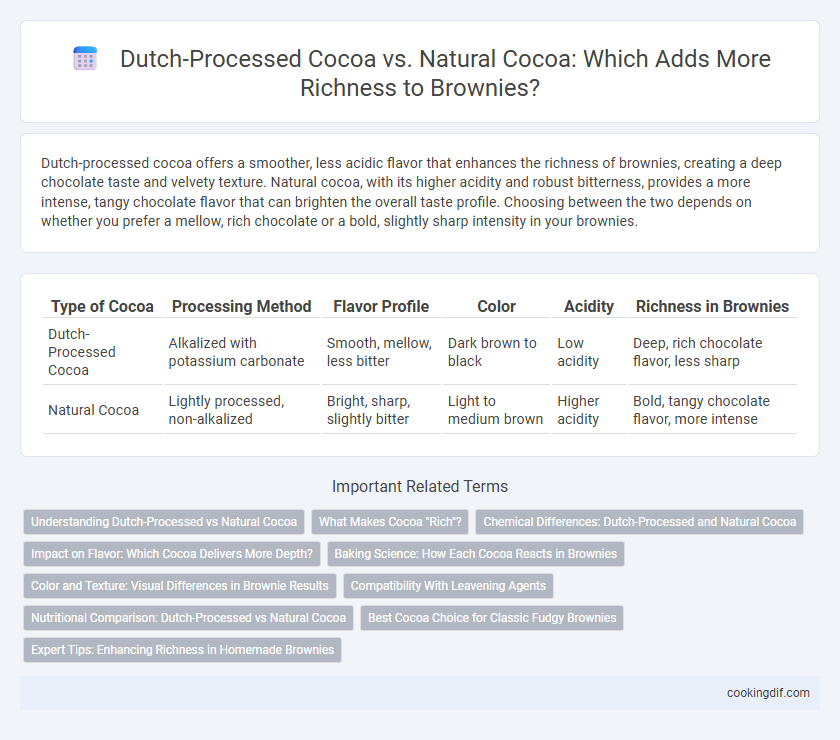Dutch-processed cocoa offers a smoother, less acidic flavor that enhances the richness of brownies, creating a deep chocolate taste and velvety texture. Natural cocoa, with its higher acidity and robust bitterness, provides a more intense, tangy chocolate flavor that can brighten the overall taste profile. Choosing between the two depends on whether you prefer a mellow, rich chocolate or a bold, slightly sharp intensity in your brownies.
Table of Comparison
| Type of Cocoa | Processing Method | Flavor Profile | Color | Acidity | Richness in Brownies |
|---|---|---|---|---|---|
| Dutch-Processed Cocoa | Alkalized with potassium carbonate | Smooth, mellow, less bitter | Dark brown to black | Low acidity | Deep, rich chocolate flavor, less sharp |
| Natural Cocoa | Lightly processed, non-alkalized | Bright, sharp, slightly bitter | Light to medium brown | Higher acidity | Bold, tangy chocolate flavor, more intense |
Understanding Dutch-Processed vs Natural Cocoa
Dutch-processed cocoa undergoes an alkalization process that neutralizes its acidity, resulting in a smoother, darker, and more mellow flavor profile ideal for rich brownies. Natural cocoa retains its acidic properties, offering a brighter, more intense chocolate flavor with a slightly fruity undertone that can enhance the complexity of baked goods. Choosing Dutch-processed cocoa contributes to deeper color and a velvety texture, while natural cocoa provides a sharper tang and stronger chocolate bite in brownie recipes.
What Makes Cocoa "Rich"?
Richness in cocoa is primarily determined by its processing method and fat content, with Dutch-processed cocoa treated with an alkalizing agent to reduce acidity and enhance smooth, deep chocolate flavors. Natural cocoa, being more acidic, offers a sharper, more intense chocolate taste but less smoothness compared to the mellow, full-bodied profile of Dutch-processed cocoa. The fat content and the presence of cocoa solids also contribute significantly to the overall richness and mouthfeel in brownies.
Chemical Differences: Dutch-Processed and Natural Cocoa
Dutch-processed cocoa undergoes an alkalizing treatment that neutralizes its acidity, resulting in a darker color and smoother, milder flavor profile compared to natural cocoa, which retains its original acidic properties. The pH level of Dutch-processed cocoa is typically around 7, while natural cocoa ranges from 5 to 6, affecting not only flavor but also chemical reactions during baking such as leavening. This chemical difference impacts the overall richness, with natural cocoa offering a sharper, more intense chocolate taste and Dutch-processed providing a deeper, less bitter flavor suitable for moist, earthy brownies.
Impact on Flavor: Which Cocoa Delivers More Depth?
Dutch-processed cocoa undergoes alkalization, which reduces acidity and imparts a smoother, milder flavor with darker coloration, enhancing the brownie's richness without the sharpness of natural cocoa. Natural cocoa retains its acidic profile, contributing a more pronounced, complex chocolate flavor that adds depth and a slight tanginess to brownies. Choosing Dutch-processed cocoa results in a richer, velvety texture, while natural cocoa delivers a bold, intense chocolate intensity that appeals to purists seeking maximum flavor complexity.
Baking Science: How Each Cocoa Reacts in Brownies
Dutch-processed cocoa undergoes alkalization, reducing acidity and resulting in a smoother, darker appearance that yields dense, fudgy brownies with a rich flavor profile. Natural cocoa contains higher acidity, which reacts vigorously with baking soda to create a lighter texture and a slightly tangy, intense chocolate taste in brownies. Understanding the chemical differences between Dutch-processed and natural cocoa ensures precise leavening and flavor balance, optimizing the brownie's moisture and crumb structure.
Color and Texture: Visual Differences in Brownie Results
Dutch-processed cocoa produces brownies with a deeper, darker color due to its alkalized treatment, which neutralizes acidity and enhances visual richness. Natural cocoa yields a lighter, reddish-brown hue, contributing to a more rustic appearance typical of classic brownies. Texture-wise, Dutch-processed cocoa often results in a smoother, denser crumb, while natural cocoa can create a slightly coarser texture with a tender bite.
Compatibility With Leavening Agents
Dutch-processed cocoa undergoes alkalization, resulting in a smoother, less acidic flavor and a darker color, making it ideal for rich brownies with a mellow chocolate taste. This type of cocoa is compatible only with baking powder, as the neutral pH does not react with baking soda, which requires acidity to activate. Natural cocoa, more acidic than Dutch-processed, produces a sharper, more intense chocolate flavor and works best with baking soda to provide proper leavening and rise in brownie recipes.
Nutritional Comparison: Dutch-Processed vs Natural Cocoa
Dutch-processed cocoa contains lower acidity and has a smoother, milder flavor compared to natural cocoa, which retains more antioxidants like flavonoids but is more acidic and bitter. Nutritionally, natural cocoa offers higher levels of antioxidants and minerals such as iron and magnesium, promoting cardiovascular health, while Dutch-processed cocoa undergoes alkalization that reduces these beneficial compounds. When choosing cocoa for brownies, natural cocoa provides greater nutritional benefits and a robust chocolate flavor, whereas Dutch-processed cocoa enhances richness and color with a less intense taste profile.
Best Cocoa Choice for Classic Fudgy Brownies
Dutch-processed cocoa offers a smoother, less acidic flavor that enhances the richness and deep chocolate taste essential for classic fudgy brownies. Its alkalized properties contribute to a darker color and more intense cocoa notes compared to natural cocoa, which tends to be more bitter and acidic. For the best chocolate depth and velvety texture, Dutch-processed cocoa is the preferred choice to achieve authentic fudgy brownie perfection.
Expert Tips: Enhancing Richness in Homemade Brownies
Dutch-processed cocoa offers a smoother, less acidic flavor compared to natural cocoa, resulting in richer, more velvety brownies. Using natural cocoa delivers a more intense chocolate punch with higher acidity, which can enhance the rise and texture of homemade brownies. Expert bakers often blend both types to balance depth of flavor and optimal crumb structure for exceptional richness.
Dutch-processed cocoa vs natural cocoa for richness Infographic

 cookingdif.com
cookingdif.com